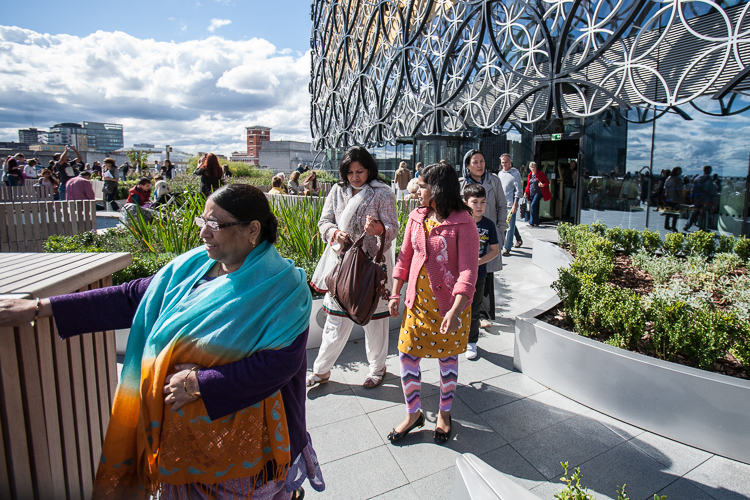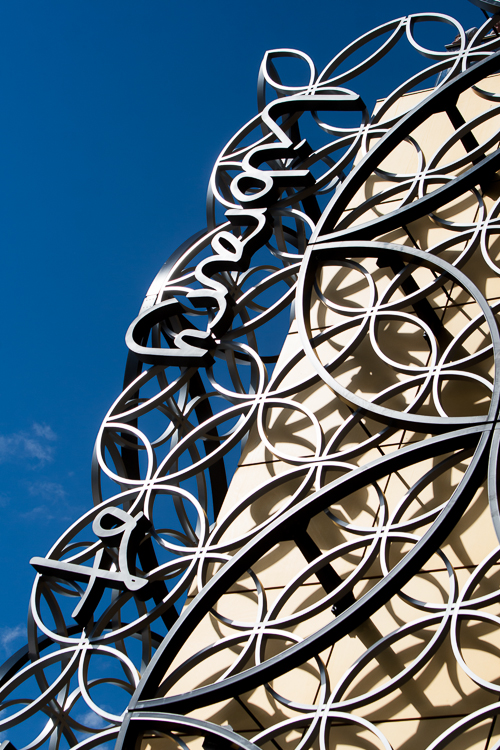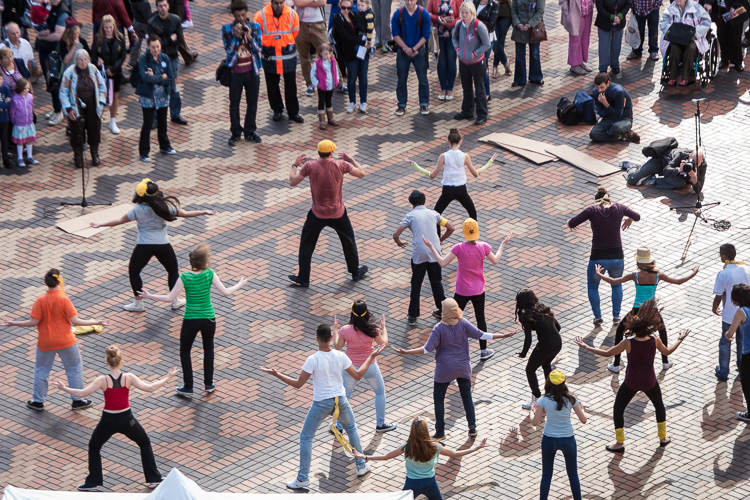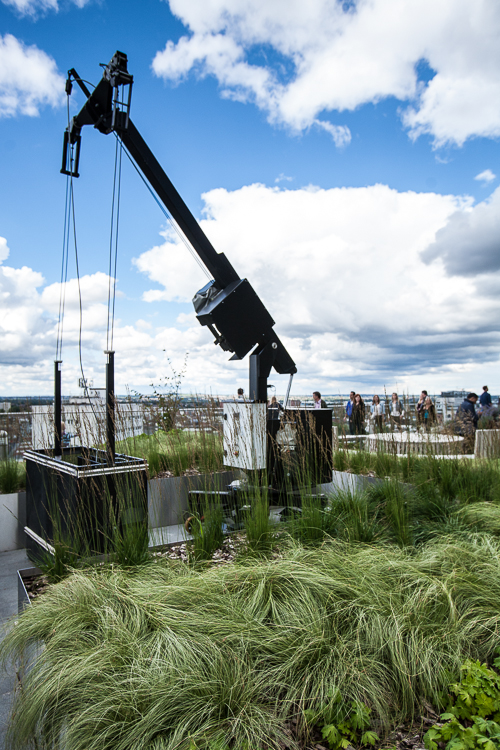I am not an architectural photographer, no I am a gardener. I am a photographer of urban life. So when we visited the Library of Birmingham terrace gardens, the Discovery Terrace and the Secret Garden, during the last week’s 4 Squares Weekender I was more curious to see up close and personal
- how the people of Birmingham embrace rooftop gardens as newly available outdoor urban spaces
- and, ultimately, how the latter shape the city experience.
Up several escalators, a short dash across the library floor – and we are on the third floor Discovery Terrace, the larger of the two. It’s teeming with people enjoying the views and photographing both the library and each other.

The terrace offered an entertaining outing experience for the whole family.

The Discovery Terrace was designed for the library visitors to enjoy the outdoor experience – sun, fresh air, the greenery – while reading books. The circular wooden decking areas provided benches inviting to sit down and unwind.

Some unwind more than others!

The terrace space is toddler friendly – there are some pool-like enclosures that help to contain the tireless (and endless) toddler movement to keep an eye on them in a busy public space.

The plants and herbs grown in the raised containers are a source of wonder for kids and an educational opportunity for their parents to explain where food comes from and how to eat healthily.


I saw this young man photographing the library metal cladding on his mobile phone – my first thought was ‘It will be a great place for backlit rooftop urban portraits!’, my second impulse was to turn and look at what he might be interested in.




The experience of this ‘ode to the circle’ continues with the aerial view on the middle pizza of the Centenary Square in front of the library – the circular lawn enticing impromptu picnics, people gathering circular pavement around the sunken hole of the amphitheatre to listen to a concert.

From certain angles the view evokes to me the Tudor manor houses – their richly patterned paved inner courtyards glimpsed through the intricate lettuce work of the upper floor windows. I can finally make peace with the circular cladding – it is not the ‘meaningless metal curtain’ as described by by some reviewers.
According to the architect, the Library of Birmingham terrace gardens were designed to relate to the city at a different scale. The lower volume and the Discovery Terrace relate more to the Centenary Square, while the upper volume and the Secret Garden – to the city scale/cityscape.
The extroverted character of The Discovery Terrace allows it not only to provide the pockets of privacy of the library goers but also to unite them to the urban life below on another level. Thus, your gaze inevitably reaches out to the busy crowds gathered in front of the REP theatre to view the dancers perform, connecting them with the outdoor garden space around.

The other side of the terrace allowed the eye to follow the pedestrian flow from the Centenary Square to the Paradise Circus.

Nigel Peake, a young Irish (almost) architect and (highly regarded) illustrator, wrote:
I begin to know a city through its fragments, walking below tall buildings, along facades of signs, doors, and windows, crossing without knowing from one district to the next, down busy streets and empty ones – some more interesting than others, but all part of this thing we call the city.
The panoramic views from the Library of Birmingham terrace gardens help their visitors to connect the city fragments they experience on the street level on a daily basis into a more cohesive urban aerial tapestry, as they watch human and car traffic tides flow back and forth though squares and bridges, past the monumental 30’s buildings, the stocky concrete 60’s and 70’s structures and the tall commercial elevations of steel and glass of the 90’s and 00’s.
The Secret Garden offers a different perspective onto the urban landscape than the lower terrace so I recommend you to make an effort and climb the stairs to the top to beat the elevator queues (oh yes, they had those last weekend, and a 60-minute wait to visit the Shakespeare Room – ooh…)


Once the vegetation in the flower beds become more lush with time the Secret Garden will certainly transform into a more introverted, intimate space. At the moment all the focal points of the terrace are exposed, which lends some clarity with regards to its landscape architecture.


Once, after paying over $20 and waiting in a 2hr queue, I stood on the 86th floor observation deck of the Empire State Building in NYC and looked down at a sprinkling of rooftop tennis courts and private gardens. I thought how ‘Babylonian’ it was – like the gardens built by King Nebuchadnezzar for his wife these modern wonders were created for the privileged few, accessible primarily to the elite and could only be marveled at from the outside.
Here in the UK more and more rooftop gardens are designed from the outset to be publicly accessible, which is amazing. In the October 2013 ‘City Living’ issue of the Dwell magazine the editorial read: ‘How we choose to live in a metropolis is dictated by many variables, from the money in our pockets to the streets at our feet, but no one person owns the experience of a city’.
Let’s hope that the library partnership with volunteer gardeners will continue maintaining the community transparency and unfettered access to these fabulous terraces. Let’s pray that the city council will not allow the new building to be brought to the same state of disrepair as the old John Madin’s brutalist structure (which John and I quite like!). Let this ‘happy little dude’ grow up and still be able to ‘unwind, socialise, and learn’ in the Library of Birmingham terrace gardens.







